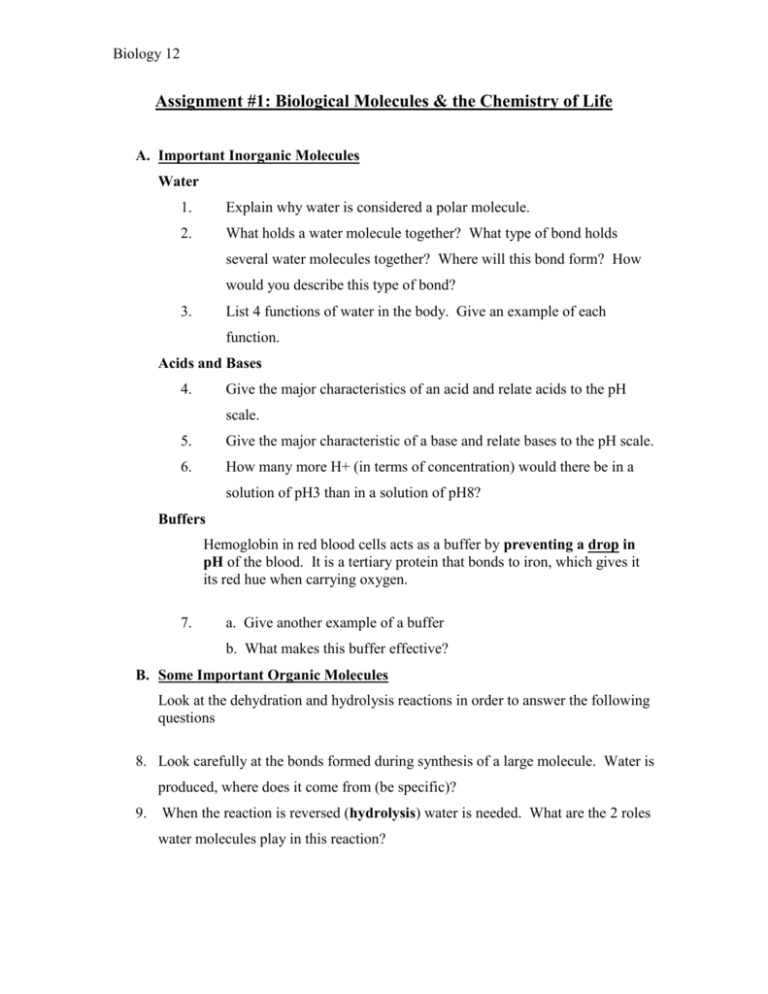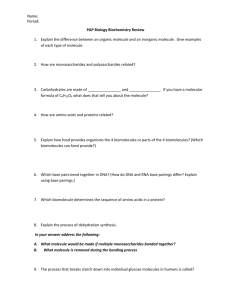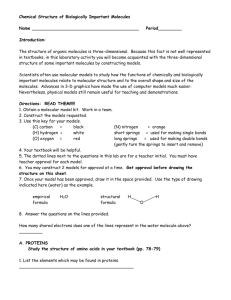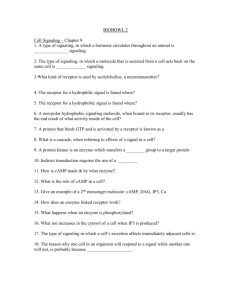Assignment #1: Biological Molecules & the Chemistry of Life
advertisement

Biology 12 Assignment #1: Biological Molecules & the Chemistry of Life A. Important Inorganic Molecules Water 1. Explain why water is considered a polar molecule. 2. What holds a water molecule together? What type of bond holds several water molecules together? Where will this bond form? How would you describe this type of bond? 3. List 4 functions of water in the body. Give an example of each function. Acids and Bases 4. Give the major characteristics of an acid and relate acids to the pH scale. 5. Give the major characteristic of a base and relate bases to the pH scale. 6. How many more H+ (in terms of concentration) would there be in a solution of pH3 than in a solution of pH8? Buffers Hemoglobin in red blood cells acts as a buffer by preventing a drop in pH of the blood. It is a tertiary protein that bonds to iron, which gives it its red hue when carrying oxygen. 7. a. Give another example of a buffer b. What makes this buffer effective? B. Some Important Organic Molecules Look at the dehydration and hydrolysis reactions in order to answer the following questions 8. Look carefully at the bonds formed during synthesis of a large molecule. Water is produced, where does it come from (be specific)? 9. When the reaction is reversed (hydrolysis) water is needed. What are the 2 roles water molecules play in this reaction? Biology 12 Proteins 10. Although many proteins are enzymes, there are many other types of proteins in our bodies. Give 4 other types of proteins (HEATS: acronym to remember types) and their role in living things. 11. Draw the structural formula of a typical amino acid. Circle the amino group, acid group and remainder. Label them. 12. Why are there twenty types of R groups? 13. What is the difference between the amino acid cysteine and the amino acid alanine, be specific. Think “R-group”. (You will have to look this up). 14. Diagram the joining of 2 amino acids together through dehydration synthesis to form a dipeptide with a peptide bond. Highlight the peptide bond. 15. a) When does a polypeptide become a protein? b) Where does this occur in a cell (think protein synthesis from bio 11)? 16. Describe the four structures proteins can assume in terms of what they are made of and the bonds holding them together. Make a sketch (very simple), for each, labeling relevant bonds. 17. What is meant by protein denaturation and what is its significance in living organisms (specifically enzymes). Carbohydrates 18. By looking at a structural formula of a molecule, how would you know you were looking at a carbohydrate? 19. How is a monosaccharide converted to a disaccharide? Give examples. What is the molecular formula for glucose? 20. How are monosaccharides converted to polysaccharides? 21. Distinguish between starch and glycogen and sugars (e.g. sucrose). Why is glucose such an important molecule? 22. How would you distinguish a cellulose molecule from a starch molecule? Why is cellulose undigestible? Biology 12 Lipids 23. Explain how a neutral fat (triglyceride) is synthesized (created). 24. Explain how a neutral fat (triglyceride) is hydrolyzed (broken apart). 25. Define what saturated and unsaturated fats mean. A “C – H” bond is considered energy rich. How much more energy do fats carry per gram than carbs? You will have to look this on up 26. Compare trans unsaturated fats to unsaturated fats and explain why one is more healthy than the other. Phospholipids 27. Differentiate between a lipid and a phospholipid. 28. Where are phospholipids found in our body? Steroids 29. a. What is the base molecule of steroids? How are steroids different from other lipids? b. Where are they made in the cell? In the body? c. List 2 examples of steroids. Nucleic Acids DNA, RNA & nucleotides- we will be going into more detail with these polymers in the future but you must know their basic structure and function now 30. What molecules make up the DNA backbone? Are they the same in RNA? 31. What are the 3 components of a nucleotide? 32. Which nitrogen bases are complimentary in DNA? In RNA? 33. Sketch a molecule of ATP and describe its structure. 34. What process produces ATP? How many ATP molecules can be made from a single glucose molecule? 35. Why is ATP the “energy currency” of the cell? 36. Copy out the ATP cycle. Since this is a cycle what does this tell you about this molecule? 37. How does our body use ATP? Biology 12 ENZYMES: BIOLOGICAL CATALYSTS 38. What is the general role of enzymes? How do they aid digestion? 39. To what group of biological molecules do they belong? 40. What process in the cell synthesizes enzymes? 41. What is the name for the reaction type that includes all digestive reactions? 42. Explain thoroughly why the reaction is called hydrolysis, and as part of your answer make a diagram as given in Fig. 6.6, Pg. 107. Use a dipeptide as the substrate, Label the active site, substrate (and its name), the actual enzyme for dipeptide digestion, and its source in your diagram. Also label: enzyme/substrate complex, products induced fit, “lock & key fit”, H2O, H+, OH-, and hydrolysis. 43. Describe what an active site is and why it is significant (lock and key)? 44. What is meant by the term “optimal temperature”? (don’t simply use the word “best”, but rather explain why it is the best temperature) 45. What is meant by the term “optimal pH”? (as above) 46. Will an enzyme catalyze a reaction if its active site is deformed? (i.e. if the enzyme is said to be denatured). Why? 47. Name 2 ways that an enzyme could become denatured. 48. Once denatured, can an enzyme regain its 3D shape? 49. What do COFACTORS do? How do they work? 50. What is the name of organic cofactors? 51. Contrast competitive and non-competitive inhibitors











